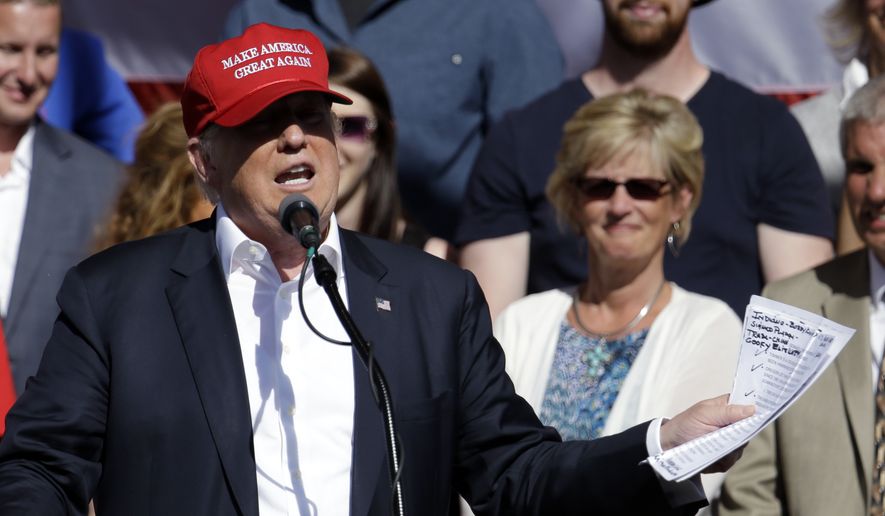OPINION:
No, the U.S. shouldn’t ever default on any of its financial obligations. And no, the U.S. should never pay its creditors less than what was guaranteed to them.
But some of Donald Trump’s debt comments make practical sense, said John Cochrane, an economist at the free-market Hoover Institution think-tank at Stanford University.
In a wide-ranging and controversial interview with CNBC last week, the GOP presidential candidate seemed to intermingle his own corporate experience within the debt markets to that of how he’d run a country. He did however, make the following statement on the national debt:
“What do we do with all of the money that we owe everybody when [interest] rates go up and now all of a sudden we have to borrow at two points more? One point more is even devastating, but two, three, four, five points more?” Mr. Trump questioned. “It’s a real dilemma, and we have to be very, very careful.”
Mr. Trump suggested the U.S. should look to lock-in historically low interest rates through refinancing, though he didn’t offer any specifics as to how.
Mr. Cochrane not only agrees with this, but he has a plan. The U.S. should be converting its national debt into 30-year-fixed-rate Treasuries or perpetuities (a bond that doesn’t have a specific maturity end-date).
“This is one of those rare times, where Donald Trump is right,” Mr. Cochrane said. “When interest rates go up, we will have to refinance at higher interest rates. Just like a homeowner chooses between a fixed-rate mortgage or floating rate, so does our government. Most of our debt is relatively short-term. So, we’re talking about paying hundreds of billions of dollars in extra money once these rates go up. In order to pay for it, we’ll have to raise taxes, lower our spending — it could become a real problem.”
The government paid $223 billion in interest in 2015, but that figure is expected to rise to $574 billion in 2021, under the assumption that the interest rate on a 10-year note will rise to 4.2 percent from 1.8 percent now, MarketWatch reports.
Mr. Cochrane has estimated the government rolls over 40 percent of its debt every year, and 65 percent within three years, meaning, the majority of the U.S. debt is held in short-term bonds. So every one to three years, the government pays these bonds and enters into new contracts — typically more short-term bonds.
If the government stays short, and the interest-rates remain low, it’s a good deal — we can buy more at lower prices. However, once these rates start to climb, we’ll be the equivalent of a homeowner who took out a subprime loan — frantically trying to find the cash to pay the higher interest rates.
Converting these short-term bonds into longer terms bonds will come at a cost; longer-term debt interest costs are a bit higher than short-term bonds. However, if you expect the Federal Reserve will eventually raise interest rates, then you’re buying these long-term bonds at a premium.
Mr. Cochrane compares the cost to earthquake insurance in California. Sure, having a home there is cheaper without it, until the earthquake hits. Moreover, the bonds proceeds can be used to buy back more short-term debt.
Some say converting the U.S. debt into long-term bonds will ultimately push interest rates higher. Mr. Cochrane says the capital markets shouldn’t be underestimated and can adjust without crashing. Additionally, counter-parties can be offered swaps by the federal government in order to manage the interest-rate risk. Turf will have to be divvied up among the Federal Reserve and U.S. Treasury.
To an extent, the U.S. Treasury is already converting its short-term bonds with longer-term ones — it’s just doing it at a slow, methodical rate, with no great impact. I asked Mr. Cochrane how long it would take to convert all of the U.S.’ $19 trillion of debt into perpetuity or 30-year bonds.
“Mechanically, they can do it an a half an hour,” Mr. Cochrane said. “We’d go to the dealer banks, say we want to buy back our old bonds, and then buy the new bonds, borrowing new money. Except for financing, there’s nothing economic about it.
“Rolling over debt is fairly painless, we’ll be able to borrow so long as the market maintains its perspective that we’re able to keep our promises,” Mr. Cochrane said.
This is where Mr. Trump’s words may have failed him — or where the media may have misinterpreted him. The U.S. can’t renegotiate the debt it’s already committed to pay. But it can make good on that debt, by going to the markets and taking on more debt, paying it off and then buying new bonds at different interest rates.
That could actually save the U.S. — and U.S. taxpayers hundreds of billions of dollars.




Please read our comment policy before commenting.